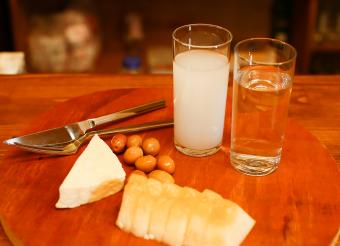
An apéritif is an alcoholic drink, such as dry wine, that is served before a meal. It stimulates the appetite and may be served alone or with light hors d'œuvres, such as cheese, antipasti, bread, or pâté.
Apéritifs Are Low in Sugar and Alcohol
Since apéritifs are meant to stimulate the appetite, they should not contain much sugar; dry is always better than sweet for appetite stimulation. Likewise, the drinks shouldn't be overly heavy, nor should they be extremely high in alcohol because all of these characteristics serve to dull the appetite instead of stimulating it.
Common Apéritifs
Many apéritifs are wine based beverages, while others are spirits. Fortified and sparkling wines make particularly delicious pre-dinner drinks, as do light cocktails.
Wine-Based Apéritifs
Some common wine-based apéritifs include the following.

- Dry Sherry: Sherry can range from light and dry to heavy and sweet. As an apéritif, choose a light, dry style of Sherry such as a Fino or a Manzanilla Fina.
- Dry Champagne or sparkling wine: Champagne and sparkling wine can also range from dry to sweet; choose the dry (brut or extra brut) versions of French Champagne or sparkling wines.
- Prosecco: Prosecco is an Italian wine that can be dry or sweet and sparkling, semi-sparkling, or flat. Choose a sparkling or semi-sparkling dry Prosecco (extra brut or brut).
- Cava: Cava is Spain's answer to Champagne. Like Champagne, Cava can range from dry to sweet. Choose a dry (brut) Cava.
- Sauvignon Blanc: With crisp grassy and herbal character, Sauvignon Blanc is the ideal apéritif wine. Try one from New Zealand's Marlborough region or a crisp and savory Sancerre from France's Loire Valley.
- Chablis: Lean and acidic Chablis from France's Burgundy wine region is an unoaked Chardonnay that has a lovely mineral and saline character to serve perfectly as an apéritif.
- Dry rosé wine: A dry rosé wine, such as a rosé from Provence in France or a crisp rosé of Pinot Noir makes a great pre-meal apéritif.
- Lillet Blanc: Lillet Blanc is a blend of citrus liqueurs and Bordeaux wine grapes that is slightly sweet and can be served chilled or on the rocks.
- Vermouth: Vermouth is an aromatized and fortified wine used in mixed drinks such as the classic Martini. Choose a dry vermouth.
- Dubonnet: If you prefer your apéritifs a bit on the sweeter side, then you may enjoy Dubonnet. It's a fortified sweet wine aromatized with herbs and spices.
Apéritif Spirits
Spirits used as apéritifs often have bitter flavors and a low sugar content. Compared to other types of spirits, apéritif spirits also tend to be reasonably low in alcohol content. You can drink apéritif spirits straight up, on the rocks, diluted with a splash, or in cocktails.

- Ouzo: Ouzo is an anise flavored liquor popular in Greece. Serve over an ice cube or add a splash of very cold water to slightly cool the beverage.
- Campari: Campari is an Italin aperitivo. It contains infusion of fruit and herbs. Serve Campari with a splash of soda over ice or use it in cocktails.
- Aperol: An Italian liqueur that is similar to Campari, Aperol is lower in alcohol and slightly less bitter. Serve it in a classic Aperol Spritz (recipe below) or other Aperol cocktails.
- Pernod and Pastis: French anise-flavored liqueurs that were originally made to replace absinthe, serve Pernod and Pastis with chilled water. Pour the liqueur into a glass and then pour the water over the top. You can add ice if you wish.
- Pimm's No. 1: Pimm's No. 1 is a gin-based liqueur fortified with fruits, bitter herbs, and quinine. Serve it over ice in lemonade or ginger ale for a classic British apéritif.
- Rakı: Rakı is a traditional Turkish or Albanian licorice-flavored liqueur. Drink it in a shot glass - or in a traditional kadeh filled with equal parts rakı and water and/or ice.
Apéritif Cocktails
You can also have apéritif cocktails before dinner. These cocktails are typically very dry, many with a slightly bitter edge.

- Negroni: This sunset colored cocktail contains Campari, gin, and sweet vermouth.
- Martini: The classic martini, made either with gin or vodka and dry vermouth, is the perfect pre-dinner apéritif.
- Vesper martini: James Bond's favorite dry martini (shaken, not stirred) is made with gin and Lillet Blanc.
- Aperol spritz (Spritz Veneziano): This drink combines 2 ounces of Prosecco, 1¼ ounces of Aperol, and a splash of soda over ice.
- Gin and tonic: The popular combination of London dry gin, lemon, and tonic water is a classic apéritif with bitter and aromatic flavor profiles.
- Vodka tonic: The less aromatic version of the gin and tonic is simple to make with a combination of vodka and tonic water served over ice.
- Kir royale: Combine 3 ounces of chilled Champagne with ⅓ ounce of crème de cassis to create a classic apéritif cocktail.
When to Serve an Apéritif
Serve an apéritif as guests arrive in the cocktail hour before dinner. Serve in smaller portions in order to keep from overfilling the stomach before a meal.
Apéritifs Versus Digestifs
There is often confusion about the difference between an apéritif and a digestif. An apéritif is meant to start a meal and is therefore not very sweet, slightly bitter, and light. A digestif, such as Galliano, is meant to be consumed after a meal as a way to stimulate digestion of what you have just eaten. Digestifs are often heavier and more full-bodied and are consumed to "finish the meal" much like you would eat dessert. These usually include sweeter or higher alcoholic beverages, such as Port, Cognac or Armagnac, or sweeter Sherries such as cream sherry. Dessert wines and sweet fortified wines also will work as digestifs, including Marsala and Madeira. Likewise, higher alcohol brown liquors such as a nice, well-rounded single malt scotch or bourbon make great digestifs.
History and Tradition of Apéritifs
Apéritifs arise from European culinary traditions, where meals were drawn-out affairs meant to be savored. The light, refreshing beverages stimulate the senses without overwhelming, providing an enticing peek at delights yet to come in the meal ahead. The term apéritif originated in France in the mid-1840s as a spicy or herbaceous wine drink that also contained malaria-fighting quinine. With its bitter flavor, many found quinine to be quite unpalatable, and the herbs, spices, and flavors of the grapes covered up the bitterness of the medicine. France, Italy, and Spain all offer their own versions of the apéritif, a tradition that has made its way to America and other parts of the world.
Apéritifs Provide the Perfect Start
Serve your guests an apéritif to stimulate their appetites before a large meal. Apéritifs are the perfect start to your next party and can be enjoyed outdoors on a warm day or in by the fire on a cool night. Whenever you decide, these beverages are light and refreshing and can be a pleasant treat to sip on while waiting on a meal.







